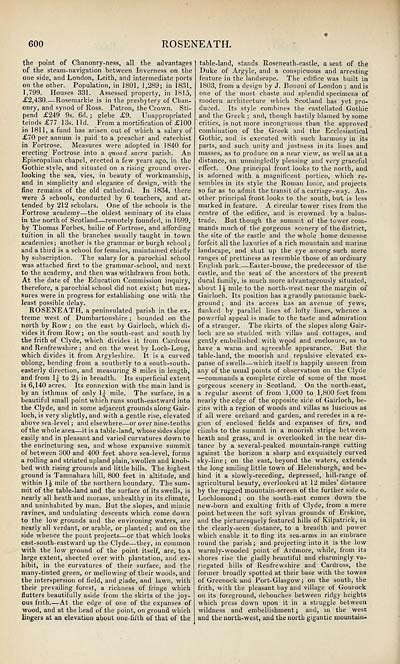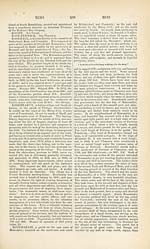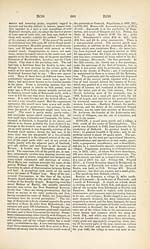Topographical, statistical, and historical gazetteer of Scotland > Volume 2
(618) Page 600
Download files
Complete book:
Individual page:
Thumbnail gallery: Grid view | List view

600
ROSENEATH.
the point of Chanonry-ness, all the advantages
of the steam-navigation between Inverness on the
one side, and London, Leith, and intermediate ports
on the other. Population, in 1801, 1,289; in 1831,
1,799. Houses 331. Assessed property, in 1815,
£2,430 Rosemarkie is in the presbytery of Chan-
onry, and synod of Ross. Patron, the Crown. Sti-
pend £249 9s. 6d. ; glebe £9. Unappropriated
teinds £77 13s. lid. From a mortification of £100
in 1811, a fund has arisen out of which a salary of
£70 per annum is paid to a preacher and catechist
in Fortrose. Measures were adopted in 1840 for
erecting Fortrose into a quoad sacra parish. An
Episcopalian chapel, erected a few years ago, in the
Gothic style, and situated on a rising ground over-
looking the sea, vies, in beauty of workmanship,
and in simplicity and elegance of design, with the
fine remains of the old cathedral. In 1834, there
were 5 schools, conducted by 6 teachers, and at-
tended by 212 scholars. One of the schools is the
Fortrose academy — the oldest seminary of its class
in the north of Scotland — remotely founded, in 1699,
by Thomas Forbes, bailie of Fortrose, and affording
tuition in all the branches usually taught in town
academies; another is the grammar or burgh school;
and a third is a school for females, maintained chiefly
by subscription. The salary for a parochial school
was attached first to the grammar-school, and next
to the academy, and then was withdrawn from both.
At the date of the Education Commission inquiry,
therefore, a parochial school did not exist; but mea-
sures were in progress for establishing one with the
least possible delay.
ROSENEATH, a peninsulated parish in the ex-
treme west of Dumbartonshire ; bounded on the
north by Row ; on the east by Gairloch, which di-
vides it from Row; on the south-east and south by
the frith of Clyde, which divides it from Cardross
and Renfrewshire ; and on the west by Loch-Long,
which divides it from Argyleshire. It is a curved
oblong, bending from a southerly to a south-south-
easterly direction, and measuring 8 miles in length,
and from ]A to 2h in breadth. Its superficial extent
is 6,140 acres. Its connexion with the main land is
by an isthmus of only 1^ mile. The surface, in a
beautiful small point which runs south-eastward into
the Clyde, and in some adjacent grounds along Gair-
loch, is very slightly, and with a gentle rise, elevated
above sea-level ; and elsewhere — or over nine-tenths
of the whole area — it is a table-land, whose sides slope
easily and in pleasant and varied curvatures down to
the encincturing sea, and whose expansive summit
of between 800 and 400 feet above sea-level, forms
a foiling and striated upland plain, swollen and knob-
bed with rising grounds and little hills. The highest
ground is Tamnahara hill, 800 feet in altitude, and
within 1 ^ mile of the northern boundary. The sum-
mit of the table-land and the surface of its swells, is
nearly all heath and morass, unhealthy in its climate,
and uninhabited by man. But the slopes, and mimic
ravines, and undulating descents which come down
to the low grounds and the environing waters, are
nearly all verdant, or arable, or planted ; and on the
side whence the point projects — or that which looks
east-south-eastward up the Clyde — they, in common
with the low ground of the point itself, are, to a
large extent, sheeted over with plantation, and ex-
hibit, in the curvatures of their surface, and the
many-tinted green, or mellowing of their woods, and
the interspersion of field, and glade, and lawn, with
their prevailing forest, a richness of fringe which
flutters beautifully aside from the skirts of the joy-
ous frith At the edge of one of the expanses of
wood, and at the head of the point, on ground which
lingers at an elevation about one-filth of that of the
table-land, stands Roseneath-castle, a seat of the
Duke of Argyle, and a conspicuous and arresting
feature in the landscape. The edifice was built in
1803, from a design by J. Bononi of London ; and is
one of the most chaste and splendid specimens of
modern architecture which Scotland has yet pro-
duced. Its style combines the castellated Gothic
and the- Greek ; and, though hastily blamed by some
critics, is not more incongruous than the approved
combination of the Greek and the Ecclesiastical
Gothic, and is executed with such harmony in its
parts, and such unity and justness in its lines and
masses, as to produce on a near view, as well as at a
distance, an unmingledly pleasing and very graceful
effect. One principal front looks to the north, and
is adorned with a magnificent portico, which re-
sembles in its style the Roman Ionic, and projects
so far as to admit the transit of a carriage-way. An-
other principal front looks to the south, but is less
marked in feature. A circular tower rises from the
centre of the edifice, and is crowned by a balus-
trade. But though the summit of the tower com-
mands much of the gorgeous scenery of the district,
the site of the castle and the whole home demesne
forfeit all the luxuries of a rich mountain and marine
landscape, and shut up the eye among such mere
ranges of prettiness as resemble those of an ordinary
English park. — Easter-house, the predecessor of the
castle, and the seat of the ancestors of the present
ducal family, is much more advantageously situated,
about lg mile to the north-west near the margin of
Gairloch. Its position has a grandly panoramic back-
ground ; and its access has an avenue of yews,
flanked by parallel lines of lofty limes, whence a
powerful appeal is made to the taste and admiration
of a stranger. The skirts of the slopes along Gair-
loch are so studded with villas and cottages, and
gently embellished with wood and enclosure, as to
have a warm and agreeable appearance. But the
table-land, the moorish and repulsive elevated ex-
panse of swells — which itself is happily unseen from
any of the usual points of observation on the Clyde
— commands a complete circle of some of the most
gorgeous scenery in Scotland. On the north-east,
a regular ascent of from 1,000 to 1,800 feet from
nearly the edge of the opposite side of Gairloch, be-
gins with a region of woods and villas as luscious as
if all were orchard and garden, and recedes in a re-
gion of enclosed fields and expanses of firs, and
climbs to the summit in a moorish stripe between
heath and grass, and is overlooked in the near dis-
tance by a several-peaked mountain-range cutting
against the horizon a sharp and exquisitely curved
sky-line ; on the east, beyond the waters, extends
the long smiling little town of Helensburgh, and be-
hind it a slowly-receding, depressed, hill-range of
agricultural beauty, overlooked at 12 miles' distance
by the rugged mountain-screen of the further side o.
Lochlomond ; on the south-east comes down the
new-born and exulting frith of Clyde, from a mere
point between the soft sylvan grounds of Erskine,
and the picturesquely featured hills of Kilpatrick, in
the clearly-seen distance, to a breadth and power
which enable it to fling its sea-arms in an embrace
round the parish; and projecting into it is the low
warmly-wooded point of Ardmore, while, from its
shores rise the gladly beautiful and charmingly va-
riegated hills of Renfrewshire and Cardross, the
former broadly spotted at their base with the towns
of Greenock and Port-Glasgow; on the south, the
frith, with the pleasant bay and village of Gourock
on its foreground, debouches between ridgy heights
which press down upon it in a struggle between
wildness and embellishment; and, in the west
and the north-west, and the north gigantic mountain-
ROSENEATH.
the point of Chanonry-ness, all the advantages
of the steam-navigation between Inverness on the
one side, and London, Leith, and intermediate ports
on the other. Population, in 1801, 1,289; in 1831,
1,799. Houses 331. Assessed property, in 1815,
£2,430 Rosemarkie is in the presbytery of Chan-
onry, and synod of Ross. Patron, the Crown. Sti-
pend £249 9s. 6d. ; glebe £9. Unappropriated
teinds £77 13s. lid. From a mortification of £100
in 1811, a fund has arisen out of which a salary of
£70 per annum is paid to a preacher and catechist
in Fortrose. Measures were adopted in 1840 for
erecting Fortrose into a quoad sacra parish. An
Episcopalian chapel, erected a few years ago, in the
Gothic style, and situated on a rising ground over-
looking the sea, vies, in beauty of workmanship,
and in simplicity and elegance of design, with the
fine remains of the old cathedral. In 1834, there
were 5 schools, conducted by 6 teachers, and at-
tended by 212 scholars. One of the schools is the
Fortrose academy — the oldest seminary of its class
in the north of Scotland — remotely founded, in 1699,
by Thomas Forbes, bailie of Fortrose, and affording
tuition in all the branches usually taught in town
academies; another is the grammar or burgh school;
and a third is a school for females, maintained chiefly
by subscription. The salary for a parochial school
was attached first to the grammar-school, and next
to the academy, and then was withdrawn from both.
At the date of the Education Commission inquiry,
therefore, a parochial school did not exist; but mea-
sures were in progress for establishing one with the
least possible delay.
ROSENEATH, a peninsulated parish in the ex-
treme west of Dumbartonshire ; bounded on the
north by Row ; on the east by Gairloch, which di-
vides it from Row; on the south-east and south by
the frith of Clyde, which divides it from Cardross
and Renfrewshire ; and on the west by Loch-Long,
which divides it from Argyleshire. It is a curved
oblong, bending from a southerly to a south-south-
easterly direction, and measuring 8 miles in length,
and from ]A to 2h in breadth. Its superficial extent
is 6,140 acres. Its connexion with the main land is
by an isthmus of only 1^ mile. The surface, in a
beautiful small point which runs south-eastward into
the Clyde, and in some adjacent grounds along Gair-
loch, is very slightly, and with a gentle rise, elevated
above sea-level ; and elsewhere — or over nine-tenths
of the whole area — it is a table-land, whose sides slope
easily and in pleasant and varied curvatures down to
the encincturing sea, and whose expansive summit
of between 800 and 400 feet above sea-level, forms
a foiling and striated upland plain, swollen and knob-
bed with rising grounds and little hills. The highest
ground is Tamnahara hill, 800 feet in altitude, and
within 1 ^ mile of the northern boundary. The sum-
mit of the table-land and the surface of its swells, is
nearly all heath and morass, unhealthy in its climate,
and uninhabited by man. But the slopes, and mimic
ravines, and undulating descents which come down
to the low grounds and the environing waters, are
nearly all verdant, or arable, or planted ; and on the
side whence the point projects — or that which looks
east-south-eastward up the Clyde — they, in common
with the low ground of the point itself, are, to a
large extent, sheeted over with plantation, and ex-
hibit, in the curvatures of their surface, and the
many-tinted green, or mellowing of their woods, and
the interspersion of field, and glade, and lawn, with
their prevailing forest, a richness of fringe which
flutters beautifully aside from the skirts of the joy-
ous frith At the edge of one of the expanses of
wood, and at the head of the point, on ground which
lingers at an elevation about one-filth of that of the
table-land, stands Roseneath-castle, a seat of the
Duke of Argyle, and a conspicuous and arresting
feature in the landscape. The edifice was built in
1803, from a design by J. Bononi of London ; and is
one of the most chaste and splendid specimens of
modern architecture which Scotland has yet pro-
duced. Its style combines the castellated Gothic
and the- Greek ; and, though hastily blamed by some
critics, is not more incongruous than the approved
combination of the Greek and the Ecclesiastical
Gothic, and is executed with such harmony in its
parts, and such unity and justness in its lines and
masses, as to produce on a near view, as well as at a
distance, an unmingledly pleasing and very graceful
effect. One principal front looks to the north, and
is adorned with a magnificent portico, which re-
sembles in its style the Roman Ionic, and projects
so far as to admit the transit of a carriage-way. An-
other principal front looks to the south, but is less
marked in feature. A circular tower rises from the
centre of the edifice, and is crowned by a balus-
trade. But though the summit of the tower com-
mands much of the gorgeous scenery of the district,
the site of the castle and the whole home demesne
forfeit all the luxuries of a rich mountain and marine
landscape, and shut up the eye among such mere
ranges of prettiness as resemble those of an ordinary
English park. — Easter-house, the predecessor of the
castle, and the seat of the ancestors of the present
ducal family, is much more advantageously situated,
about lg mile to the north-west near the margin of
Gairloch. Its position has a grandly panoramic back-
ground ; and its access has an avenue of yews,
flanked by parallel lines of lofty limes, whence a
powerful appeal is made to the taste and admiration
of a stranger. The skirts of the slopes along Gair-
loch are so studded with villas and cottages, and
gently embellished with wood and enclosure, as to
have a warm and agreeable appearance. But the
table-land, the moorish and repulsive elevated ex-
panse of swells — which itself is happily unseen from
any of the usual points of observation on the Clyde
— commands a complete circle of some of the most
gorgeous scenery in Scotland. On the north-east,
a regular ascent of from 1,000 to 1,800 feet from
nearly the edge of the opposite side of Gairloch, be-
gins with a region of woods and villas as luscious as
if all were orchard and garden, and recedes in a re-
gion of enclosed fields and expanses of firs, and
climbs to the summit in a moorish stripe between
heath and grass, and is overlooked in the near dis-
tance by a several-peaked mountain-range cutting
against the horizon a sharp and exquisitely curved
sky-line ; on the east, beyond the waters, extends
the long smiling little town of Helensburgh, and be-
hind it a slowly-receding, depressed, hill-range of
agricultural beauty, overlooked at 12 miles' distance
by the rugged mountain-screen of the further side o.
Lochlomond ; on the south-east comes down the
new-born and exulting frith of Clyde, from a mere
point between the soft sylvan grounds of Erskine,
and the picturesquely featured hills of Kilpatrick, in
the clearly-seen distance, to a breadth and power
which enable it to fling its sea-arms in an embrace
round the parish; and projecting into it is the low
warmly-wooded point of Ardmore, while, from its
shores rise the gladly beautiful and charmingly va-
riegated hills of Renfrewshire and Cardross, the
former broadly spotted at their base with the towns
of Greenock and Port-Glasgow; on the south, the
frith, with the pleasant bay and village of Gourock
on its foreground, debouches between ridgy heights
which press down upon it in a struggle between
wildness and embellishment; and, in the west
and the north-west, and the north gigantic mountain-
Set display mode to: Large image | Transcription
Images and transcriptions on this page, including medium image downloads, may be used under the Creative Commons Attribution 4.0 International Licence unless otherwise stated. ![]()
| Gazetteers of Scotland, 1803-1901 > Topographical, statistical, and historical gazetteer of Scotland > Volume 2 > (618) Page 600 |
|---|
| Permanent URL | https://digital.nls.uk/97501379 |
|---|
| Description | Volume second. I-Z. |
|---|---|
| Attribution and copyright: |
|

